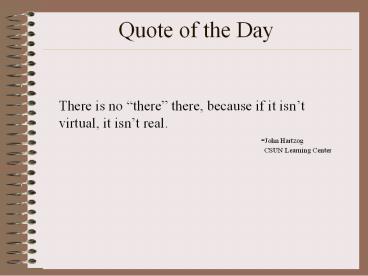Quote of the Day - PowerPoint PPT Presentation
Title:
Quote of the Day
Description:
Title: PowerPoint Presentation Author: Jerald Schutte Last modified by: Schutte, Jerald G Created Date: 10/26/2002 6:45:31 AM Document presentation format – PowerPoint PPT presentation
Number of Views:41
Avg rating:3.0/5.0
Title: Quote of the Day
1
Quote of the Day
There is no there there, because if it isnt
virtual, it isnt real. -John
Hartzog CSUN Learning Center
2
Data sources Four alternatives
I. Reactive Measures (Potential for Hawthorne
Effect)
A. Ask Someone Directly Survey Research
B. Ask Someone else to Report - Observation
II. Non-Reactive Measures (Unobtrusive data )
C. Make up the data - Simulation
D. Use anothers Data - Existing Data
3
Unobtrusive / Non-Reactive Measures
I. Simulation
Definition A model or representation of a
process involving 1) a definition of the
components 2) their relationship and 3) the
realization of an outcome.
Generally used when 1) Time frame is
restricted 2) the Scope is too broad or 3)
there are ethical considerations
Involves three contexts in which data is
generated 1) Pure Machine 2) Person-Machine
and 3) Pure Person..
4
Simulation
- Types
A. Pure Machine
The computer creates both the independent and
dependent variables by 1) making assumptions 2)
specifying a functional relationship and 3)
calculating their outcomes. Also known as Math
Modeling
B. Person-Machine
The computer creates the the independent variable
while the person responds, thereby creating the
dependent variable. Also known as Computer
Mediated Simulation
C. Pure-Person
The persons involved create both the independent
and dependent variables through contingent
interaction. Also known as Game Theory.
5
Pure Machine Example
Graph Theory
Sociomatrix (A)
Sociomatrix (A x A)
In graph notation, the circles are people and the
arrows are relationships (one direction for
asymmetric relations, double headed for
reciprocal relations).
The matrix reflects the graph in that the rows
are the choosers and the columns are those
chosen there is a 1 present if the relation
exists, 0 otherwise.
A mutual choice pair matrix can be obtained
easily via computer by multiplying the matrix
times its transpose (the matrix rotated 90
degrees). This can be further multiplied to
obtain all three-way mutual choices-the typical
minimum definition for a clique in social groups.
6
Pure Machine - Types
In general there are three criteria by which to
categorize mathematical models
1. Deterministic vs. Probabilistic
Are we analyzing all or some of the elements?
2. Static vs. Dynamic
Is the measurement happening once or over time?
3. Discrete vs. Continuous
Is the measurement whole numbers or include
fractions?
7
Pure-Person Example
I. Zero-sum Games
- Ones gain is anothers loss
II. Non-Zero-sum Games
- Joint gains and losses
A. Cooperative
B. Non-Cooperative (Prisoners Dilemma)
The Definition is 1) TgtRgtPgtS and 2) 2RgtTSgt2P
The name comes from the best individual outcome
being in direct conflict with best collective
outcomes
Here the individual and collective outcomes are
the same that is, both cooperate. Hence there
is no dilemma. This is a non-zero sum
cooperative game.
These numbers reflect the prisoners dilemma
described above. Because the individual and
collective motive are in conflict, we call this a
mixed motive or non-zero-sum non-cooperative game.
8
Unobtrusive Measures Existing Information
I. Secondary Analysis
- Data Based
Public Sources Bureau of Census
Private Sources ICPSR
II. Content Analysis
- Text Based
Public Sources Thomas
Private Sources DataWarehouse































